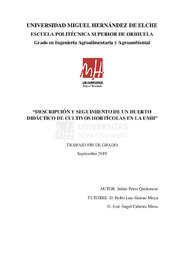Por favor, use este identificador para citar o enlazar este ítem:
https://hdl.handle.net/11000/6567Registro completo de metadatos
| Campo DC | Valor | Lengua/Idioma |
|---|---|---|
| dc.contributor.advisor | Guirao Moya, Pedro | - |
| dc.contributor.advisor | Cabrera Miras, José Ángel | - |
| dc.contributor.author | Pérez Quiñonero, Julián | - |
| dc.date.accessioned | 2020-10-30T12:54:19Z | - |
| dc.date.available | 2020-10-30T12:54:19Z | - |
| dc.date.created | 2019-09 | - |
| dc.date.issued | 2020-10-30 | - |
| dc.identifier.uri | http://hdl.handle.net/11000/6567 | - |
| dc.description.abstract | En este trabajo se realiza un huerto didáctico con diferentes cultivos hortícolas de primavera-verano. Se describen las características de la parcela, la preparación del terreno, el cálculo de riego, el trasplante, la colocación de microtúneles, el seguimiento de las plagas y enfermedades, y la recolección. Las plagas que han ido apareciendo a lo largo del ciclo han sido: el pulgón negro del algodón Aphis gossypii, la mosca blanca del tabaco Bemisia tabaci y el trips occidental de las flores Frankliniella occidentalis, pero su nivel no ha sido determinante para el desarrollo de los cultivos, por lo que no ha sido necesario realizar ningún tratamiento. En el caso de las enfermedades, el oídio de las cucurbitáceas ha sido el más importante y hubiera sido conveniente aplicar algún tratamiento fungicida para disminuir sus daños. Las cosechas en la berenjena, calabacín y sandía han sido razonables, adecuadas para este tipo de huerto didáctico. En el melón, la cosecha se ha visto mermada y en el caso del pimiento, las plantas presentaban muy pocos frutos al finalizar el curso. | es |
| dc.description.abstract | In this work a didactic orchard is made with different spring-summer horticultural crops. The characteristics of the plot are described, the preparation of the land, the calculation of irrigation, the transplant, the placement of microtunnels, the monitoring of pests and diseases, and harvesting. The pests that have been appearing throughout the cycle have been: the black cotton aphid Aphis gossypii, the tobacco whitefly Bemisia tabaci and the western flower thrips Frankliniella occidentalis, but their level has not been determinant for the development of crops, so no treatment has been necessary. In the case of diseases, the powdery mildew of cucurbits has been the most important and it would have been convenient to apply some fungicide treatment to reduce its damage. The harvests of aubergine, courgette and watermelon have been reasonable, suitable for this type of didactic orchard. In the melon, the harvest has been reduced and in the case of the pepper, the plants had very few fruits at the end of the course. | es |
| dc.format | application/pdf | es |
| dc.format.extent | 59 | es |
| dc.language.iso | spa | es |
| dc.rights | info:eu-repo/semantics/openAccess | es |
| dc.subject | Huertos escolares | es |
| dc.subject.other | CDU::6 - Ciencias aplicadas::63 - Agricultura. Silvicultura. Zootecnia. Caza. Pesca | es |
| dc.title | Descripción y seguimiento de un huerto didáctico de cultivos hortícolas en la UMH | es |
| dc.type | info:eu-repo/semantics/bachelorThesis | es |

Ver/Abrir:
TFG Pérez Quiñonero, Julián.pdf
4,23 MB
Adobe PDF
Compartir:
 La licencia se describe como: Atribución-NonComercial-NoDerivada 4.0 Internacional.
La licencia se describe como: Atribución-NonComercial-NoDerivada 4.0 Internacional.
.png)